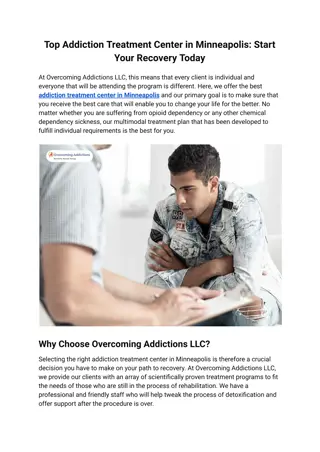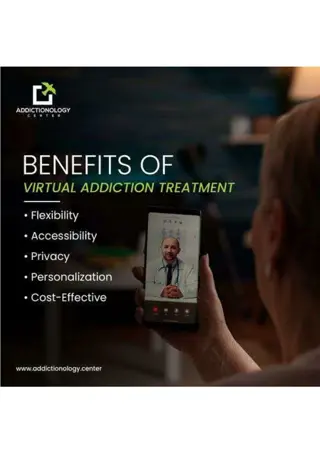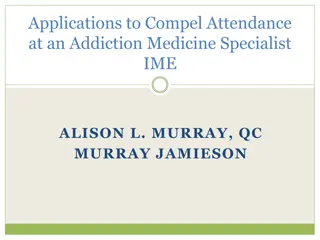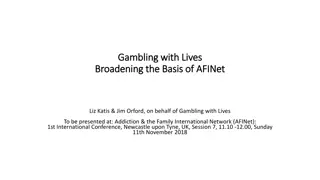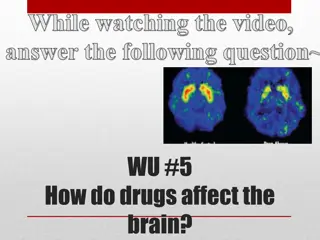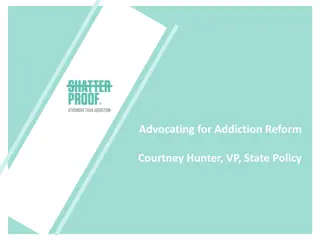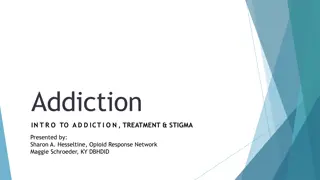Understanding Drugs: Impact, Addiction, and Statistics
Drugs, whether legal or illegal, have profound effects on the body and mind. They can be used for diagnosis, treatment, or recreation but also carry risks of addiction and harm. Research shows millions struggle with drug addiction, with substances like alcohol, marijuana, and cocaine being commonly abused. Statistics reveal the widespread impact of drug use globally, highlighting the need for awareness and prevention efforts.
Download Presentation

Please find below an Image/Link to download the presentation.
The content on the website is provided AS IS for your information and personal use only. It may not be sold, licensed, or shared on other websites without obtaining consent from the author. Download presentation by click this link. If you encounter any issues during the download, it is possible that the publisher has removed the file from their server.
E N D
Presentation Transcript
Natural or synthetic substance which (when taken into a living body) affects its functioning or structure, and is used in the diagnosis, mitigation, treatment, or prevention of a disease or relief of discomfort. Also called legal drug or medicine. A legal or medicinal drug however, can be harmful and addictive if misused. or a medicine or other substance which has a physiological effect when swallowed or otherwise introduced into the body
1. processes of the mind or body. 2. diagnosis, treatment, or prevention of disease or other abnormal condition. 3. on the central nervous system, such as a narcotic. 1. a chemical substance that affects the 2. any chemical compound used in the 3. a substance used recreationally for its effects
A drug is any substance, solid, liquid or gas that changes the functions or structures of the body in some way. This excludes food and water, which are required to maintain normal body functioning. The drugs of most concern to the community are those that affect a person's central nervous system. These are the psychoactive drugs. They act on the brain and can change the way a person thinks, feels or behaves.
A relevant research has shown that there are almost 22 million drug victims in the North American Alcoholism, psychotherapeutic and Cocaine are the most common outcomes which arise a drug addiction. Drugs have been part of our culture since the middle of the last century. Popularized in the 1960s by music and mass media, they invade all aspects of society. continent alone. Marijuana,
An internationally consume illegal drugs. In the United States, results from the 2007 National Survey on Drug Use and Health showed that 19.9 population aged 12 or older) used illegal drugs in the month prior to the survey. The most commonly used and abused drug in the US is accidents are the second leading cause of teen death in the United States. estimated 208 million people million Americans (or 8% of the alcohol. Alcohol-related motor
The marijuana. According to the United Nations 2008 World Drug Report, about 3.9% of the world s population between the ages of 15 and 64 abuse marijuana. In Europe, recent studies among 15- and 16-year-olds suggest that use of marijuana varies from under 10% to over 40%, with the highest rates reported by teens in the Czech Republic (44%), followed by Ireland (39%), the UK (38%) and France (38%). In Spain and the United Kingdom, cocaine use among 15- to 16-year- olds is 4% to 6%. Cocaine use among young people has risen in Denmark, Italy, Spain, UK, Norway and France. most commonly used illegal drug is
Country Substance Total Number of Addicts (approx.) Per Capita Iran Heroin 95,000,00 14.32% United Kingdom Alcohol 81,3000 13.65% France Prescription pills 85,000,0 13.2% Slovakian Inhalants 7,000,0 13.01% Russia Alcohol 100,000 7.1% Afghanistan Heroin 24,3000 6.9% Canada Pot 22,3000 6.4% United States Prescription pills 192,9000 6.2% Brazil Oxi 84,3000 4.29% Mexico Meth 14,1000 3.9%
Drugs are derived from a range of sources. Many are found in plants, for example nicotine in tobacco; caffeine in coffee beans; and cocaine from the coca plant. Morphine and codeine are derived from the opium poppy, while heroin is produced by the chemical modification of morphine. Marijuana is the leaf, buds and seed heads of the cannabis plant, while hashish and hash oil are the plant's resin (gum).
Alcohol is produced by the natural process of fermentation that happens when fruit, grain or vegetables decompose. Certain fungi, such as magic considered hallucinogenic properties. Medicines can be manufactured from both natural and artificial chemicals. mushrooms and cactus because plants, of are their drugs
A number of state and national surveys have been conducted to assess the extent of drug use in Australia. These surveys provide clear evidence that Australia is a nation of drug users. The 2004 National Drug Strategy Household Survey (NDSHS) estimates that of the Australian population aged 14 years and over, at some time in their lives:
90.71% had used alcohol; 47.1% had used tobacco; 33.61% had used marijuana; 5.5% had used analgesics (pain-killers); 2.8% had used tranquillizers/sleeping pills; 7.5% had used hallucinogens; 7.5% had used ecstasy; 4.7% had used cocaine; 2.5% had used inhalants; 1.4% had used heroin; 0.3% had used steroids; and 0.3% had used methadone.
The three main types of drugs, classified by their effects on the central nervous system are: Depressants; Stimulants; and Hallucinogens.
Depressant drugs slow down, or depress, the functions of the central nervous system (however, they don't necessarily make you feel depressed). Depressant drugs include: alcohol; opiates (a drug containing opium )and opioids: including heroin (also known as 'H', 'hammer', 'smack' and 'gear'), morphine, codeine, methadone. cannabis: (also known as 'green', 'smoke', 'weed', 'pot', 'dope', 'cone' and 'mull'), including marijuana, hashish and hash oil. minor tranquillisers:including diazepam (Valium), oxazepam (Serepax), nitrazepam (Mogadon), temazepam and some solvents and inhalants: including vapors from petrol, glue, chrome paint and lighter fluid.
In moderate doses, depressants can make you feel relaxed. Some depressants cause euphoria (a feeling of happiness) and a sense of calm and well-being. They may be used to 'wind down' or to reduce anxiety, stress or inhibition(shyness). Because they slow you down, depressants affect coordination, concentration and judgment. This makes driving and operating machinery dangerous.
In larger doses, depressants can cause unconsciousness by reducing breathing and heart rate. A person's speech may become unclear and their movements sluggish (lazy) and uncoordinated. Other effects of larger doses including nausea, vomiting and, in extreme cases, death. When taken in combination, depressants increase their effects and increase the danger of overdose.
In contrast to depressant drugs, stimulant drugs speed up the functions of the central nervous system. Millions of People use the following stimulants every day: caffeine: most coffee, tea and cola drinks contain caffeine, which is a mild stimulant; nicotine: the nicotine in tobacco is a stimulant, despite many smokers using it to relax; and ephedrine: used in medicines for bronchitis, fever and asthma.
Stimulants speed up or stimulate the central nervous system and can make the users feel more awake, alert or confident. Stimulants increase heart rate, body temperature and blood pressure. Other physical effects include reduced appetite, talkativeness, agitation (tension) and sleep disturbance.
Hallucinogenic drugs mislead the user's perceptions of reality. These drugs include: LSD (lysergic acid diethylamide): also known as 'trips', 'acid' and 'microdots'; magic mushrooms : also known as 'mushies'; mescaline (peyote cactus); and ecstasy : also known as 'E', 'XTC' and 'Eccies', produces a combination of hallucinogenic and stimulant effects; and ketamine: also known as 'K' and 'Special K'. Ketamine is a drug for use in human and veterinary medicine developed by Parke-Davis (1962). Like other pharmaceuticals of this type, ketamine is used as a recreational drug.
The main physical effects of hallucinogenic drugs are loss of appetite, increased activity, talking or laughing, jaw clenching, sweating and sometimes stomach cramps or nausea. Drug effects can include a sense of emotional and psychological rapture and well-being. Visual, auditory and tangible hallucinations may occur, causing users to see or hear things that do not actually exist. The effects of hallucinogens are not easy to predict and the person may behave in ways that appear irrational or odd. Psychological effects often depend on the mood of the users and the context of use.
Negative effects of hallucinogens can include panic (terror), fear and loss of contact with reality. In extreme cases, this can result in dangerous behavior that can put the user and others at great risk. Driving while under the influence of hallucinogens is extremely risky. It is common for users to take minor tranquillizers or marijuana to help them come down from a hallucinogenic drug.
Most of the diseases of the world has a medical solution or medical cure but there are some diseases which could not be cured through medicines alone. Drug addiction is one of those diseases which could not be cured through medicines only. It need a societal solution, a spiritual solution, a psychological solution i.e. we need a whole treatment plan composed of different modification tools, counseling plus medication etc. therapeutic techniques, behavior
Treatment plan for drug addicts is divided into three 3 phases 1. Pre-treatment phase 2. Treatment phase 3. Post-treatment phase In each and every phase we need a whole team of professional for planning. We need psychologists, we need counselors, we need social workers, we need family, we need his friends and peer support etc. social worker professional skills and trainings. He has already studied about the drugs, its effects, addiction and how to contribute in its treatment plan. is one among the team members with
What can social worker do in the awareness phase? It is the duty of social worker to create awareness among young people, particularly students and parents as well. He explains the dark effects of drugs to the younger one and shows the symptoms of an addict to the parents. It is the duty of the social worker to go to the street patients and conduct counseling sessions with them. The social worker has to motivate him. As social worker is aware of the society and how does it work, and he is aware of the human growth and development so therefore, due to these specialties it is his job to create awareness and to start a beginning of change.
After detoxification and medicated prevention, the real work of the social workers begins. When the client becomes conscious of his environment i.e. when the poison is removed from his body, social worker interviews the patient. The aim of the 1st interview is to get information about the client. He tries to find out what were the causes which lead him for addiction. He asks the client of his past. He also tries to find out the potentials, capabilities, weaknesses and limitations of the client. He looks for the resources i.e. his family, friends and other resources.
Now when social worker has a complete study of the case, and has sufficient knowledge about the client and his problem, he then diagnoses him. He looks for the alternatives so that his client spends his leisure time in those activities. In the diagnosis stage, the actual causes which lead the client to addiction is find out. An action plan is made for the client. He is given different counseling in individual and group form. He explains to his patient his qualities and capabilities. He creates a sense of worth importance. in the client. He tells him about his
When the client is ready to go back to his home, social worker helps the patient and his family to understand each other. The patient after treatment is no more addicted. He is now a normal person. The family should accept him as a normal human being. The patients who are in need of financial assistance worker also help them to overcome this problem. social worker provide good environment to the patient who is being rehabilitated. So that he may not indulge into the addiction again. in the rehabilitation process, social
Different technical skills are taught to the patients. So that they may be able to get a job for themselves or start their own business. Religious therapies can be given in the mosques through the imam. The community and he could tell his villagers that how they have to look at him now. social worker visits his home and





